In 2024, email marketing is still a very valuable tool for your online business, or any business actually, to reach your customers and keep them up to date with specials, events or anything happening with the business.
Despite the rise of social media and other digital platforms used to contact or inform users, email marketing continues to deliver impressive results and be one of the top converting forms of communication.
Whichever type of business you have, email marketing allows you to reach your audience directly, build strong relationships, and it is very good for driving sales for products and services you are offering.
So yes! Learn email marketing today!
In this guide to email marketing, I will walk you through all the basics and more advanced techniques for you to learn email marketing and get started easily. I’ll provide practical tips and strategies to help you optimize your email campaigns and leverage email marketing effectively for your business.
Do You Need to Learn Email Marketing in 2024?
In today’s world, I’d say you should learn email marketing, it’s really important if you want to grow your business or improve your marketing skills.
Email marketing is one of the best ways to keep a connection and reach out to engage with your audience because it allows you to communicate with them directly… and user usually respect and engage with emails more.
Whether you own a small business, work in marketing, or are starting a new venture, if you learn email marketing it can really help you build better customer relationships, increase sales, and achieve your goals.
Email marketing is a cost-effective tool that can give you a great return on investment, making it very valuable if you understand it.
Why Email Marketing is Affective
Email marketing is effective because it allows you to reach your audience directly in a personalized and targeted way, and to drive traffic to your website or online store.
Studies have also shown that email marketing has a higher return on investment compared to other marketing channels, thanks to its ability to nurture leads, build customer loyalty, and drive repeat purchases.
Unlike social media, where your message can either just be ignored or get lost in the noise, emails land straight in the recipient’s inbox, making them more likely to be seen and acted upon.
Popular Email Marketing Strategies

Personalization: Personalizing your emails to use the recipient’s name or other details will increase engagement.
Segmentation: You can divide your email list into smaller groups based on demographics, interests, or past behavior to send more relevant content to selected users.
Automated Email Campaigns: When you learn email marketing, you will also learn email automation, which is to send timely emails based on user actions, such as welcome emails, abandoned cart reminders, and post-purchase follow-ups.
A/B Testing: Testing different email elements, like subject lines or call-to-action buttons, is a great way to see what works best and which versions convert better.
Mobile Optimization: Your emails are most likely getting read from a phone or tablet nowadays, so make sure your emails look great and are easy to read on mobile devices. Stats from Statista say over 50% of users open emails on mobile.
Clear Call-to-Actions (CTAs): Make sure you’re using strong and clear CTAs to guide your readers towards the desired action.
The 3 Core Phases: How Email Marketing Works
Research suggests that it takes an average of 8 touch points to make a sale, and usually the first touch point comes from the user finding you on Google or linking through to your site or funnel from social media, but what’s that chance of that user bookmarking your site or coming back on their own?
I’ll tell you… It’s a very slim chance!
So… Offer them something valuable in exchange for their email address, and voila!.. You have a way to contact them and nurture them into learning about your brand and hopefully becoming a customer.
And that brings us to the first phase:
1) Building your email list
The first phase of email marketing is creating a strong and engaged email list for your business.
Unfortunately… People don’t like giving out their email address to just anyone, so you need to give them something in return.
So a good strategy involves attracting your potential subscribers through various different methods such as sign-up forms on your website, where you offer valuable lead magnets like eBooks or discounts for the users to sign up.
The key is to provide users with value and make the decision and sign up process easy for people that would want to join your list.
Offering Lead Magnets:
The chance that someone will just sign up to your list on their own is kinda rare so offering a lead magnet which gives the user some value will increase that chance by a lot.
Think of a lead magnet that someone learn something from, can apply right away, and can quickly get results from.
Some lead magnet ideas:
E-books: Comprehensive guides on specific topics or learning something.
Checklists: Step-by-step guides for specific tasks.
Templates: Pre-designed templates for web pages, documents, presentations, etc.
Free Trials: Limited-time access to your product or service.
Discount Codes: Exclusive discounts on your products or services.
Case Studies: Detailed success stories and analyses.
Infographics: Visual representations of data and concepts.
Worksheets: Interactive sheets for goal setting or problem-solving.
Resource Libraries: Curated collections of useful links and tools.
Video Tutorials: Step-by-step video guides.
Email Courses: Sequential educational content delivered via email.
When offering your lead magnet, don’t make it too broad, stick within your niche if you have one and (again) make sure you’re providing the user with value so that they’re interested in signing up.
Your Sign up or Email Capture Form:
Keep it simple!
I suggest keeping your email capture form simple with just name, email and the submit button, or even just the email and submit button, making it super quick and easy for the users to sign up.
Where to put your email capture forms:
Popup and Screen-fillers: This form is more aggressive, but they tent to convert the best over other email capture forms displayed. I suggest using this type.
Slide-ins or Fixed Position Forms: These appear in a fixed position at the top or bottom (on left or right) of the website, and slide-ins, which appear as the user scrolls down the page.
The least aggressive and perhaps most traditional are:
Website Footer: Displays just above the footer on all pages. I suggest also using this type.
Page Sidebar: Usually on the blog post pages, situated in the sidebar with other widgets.
Dedicated Page: I wouldn’t suggested using this form as it’s another page load and you could lose the user in the process.
2) Managing your email list
Once you have built (and continue building) your email list, the next phase is managing it effectively.
Segmenting your Email List:
Managing your email list includes segmenting your subscribers into different groups based on their interests, behaviors, or demographics to ensure you send them relevant content.
Depending on the email platform you’ve chosen, this is usually done using tags, custom fields or custom filters… These platforms provide robust tools to help you create effective segments, ensuring that your email marketing campaigns are relevant and targeted to the right audience.
Regularly cleaning your list by removing inactive subscribers is also crucial to maintain a healthy list and improve your email deliverability rates.
And… always make it easy for the user to unsubscribe if they are not or no longer interested in receiving your emails. If they are not interested in your products or business, then you wouldn’t want them in your list anyway.
3) Emailing your email list
The final phase is sending out your emails.
This involves creating and scheduling email campaigns that will resonate with your audience. You can send emails whenever you like or whenever you have new specials or products to offer, or just want to inform your users and build some more brand awareness.
Use personalization to address subscribers by name and tailor content to their preferences. Keep your emails engaging with clear calls to action, eye-catching designs, and valuable information.
Email Automation:
Besides drafting and sending out a single email to everyone on your list, I also suggest setting up a series of automated emails so that your users hear from you regularly after signing up.
This is a great way to create a stronger brand awareness and knock out a couple more touch points as mentioned above.
You can even build email automations based on segments in your audience, using those tags and custom fields I mentioned above under Segmenting your Email List.
The great thing about email automation is that it’ll run without needing you there… So, invest some time setting up email automations for your business and they will work for you for years to come.
Copywriting for your Emails:
In today’s online world, whether you have a website or a sales funnel, effective copywriting is crucial… And I don’t mean long well written stories.
I mean good, personal copy builds trust, drives conversions, and conveys your message clearly, making it a key component of successful email marketing strategies. Here are some of my extra copywriting tips:
Write the Way You Talk: Use a conversational tone to make your emails feel more personal and engaging. Imagine you’re talking to a friend and keep the language natural and friendly.
Keep It to the Point and get Personal: Be direct. Subscribers appreciate brevity and clarity. Avoid unnecessary long stories and get straight to the value you’re providing. Use your subscriber’s name if you can, and reference past interactions or purchases if possible. This makes the email feel more tailored and relevant to the person reading it.
Have Clear Call to Actions (CTAs): Ensure your emails have a clear and compelling CTA. Whether it’s to read a blog post, download a resource, or make a purchase, make sure it’s easy for the subscriber to know what action to take next.
Types of Emails:
You can select between using HTML email and/or plain text emails… Each have their Pro’s and Con’s… Personally I like plain text emails as they feel more like you’re receiving an email from a friend.
But let’s look at the pro’s and con’s of each
HTML Emails
Pros:
- Visual Appeal: HTML emails can include images, colors, and styled text, making them visually engaging and more likely to capture the reader’s attention.
- Branding & Interactive Elements: HTML emails allow for consistent branding by incorporating logos, brand colors, and specific fonts, and can include buttons, clickable links, and other interactive elements, making it easier for recipients to engage with your content.
Cons:
- Spam Filters: HTML emails are a little more likely to be flagged by spam filters if not properly optimized.
- Possible Rendering Issues: They can look different across various email clients and devices, which can affect the user experience.
Plain Text Emails
Pros:
- Personal Touch: They can feel more personal and genuine, which might be better for relationship-building emails.
- Deliverability: Plain text emails are less likely to be marked as spam, ensuring higher deliverability rates.
- Simplicity: They are straightforward and easy to read on any device or email client.
Cons:
- Lack of Visual Appeal: They lack the visual elements that can make an email more engaging and memorable.
Then… Besides just choosing between if you’re going to do HTML emails or plain text emails… You can also set up:
Relationship Building Emails: Aimed at creating and maintaining a long-term connection with your subscribers by providing valuable and engaging content. These emails use a more conversational and friendly tone, and focus on building trust and rapport over time rather than pushing for sales or mentioning products.
Personalization is key, tailoring content to your audience’s interests and preferences. By offering insights and creating a sense of community, relationship building emails help maintain a positive brand awareness and encourage loyalty.
Examples:
- Welcome emails
- ‘Get to know you’ or ‘Your Story’ emails
- Birthday or anniversary emails
- Educational content and tips
OR
Sales Emails: After building brand awareness and rapport, sales emails are designed to drive conversions and get your audience to take specific actions, such as making a purchase or signing up for a service.
Sales emails give clear and compelling call-to-actions, and also highlight the key benefits and features of your product or service. You can also create a sense of urgency through time-limited offers or exclusive deals. While personalized, these emails focus on addressing the the users needs and presenting the product as the best solution.
Examples:
- Product launch announcements
- Promotional emails
- Discount and offer emails
- Abandoned cart emails
And remember… after you learn email marketing… Consistency is key, so ensure that you have a regular email schedule to keep your audience engaged and informed.
What type of Businesses will Email Marketing work for?
Email marketing will work well for many, or almost any, types of businesses, no matter their size or industry… So learn email marketing today!
Small businesses, local shops, big companies, and online stores can all benefit from it. Retail businesses can use email to promote new products and sales, service companies can share useful information and updates, and B2B companies can build relationships with other businesses.
Even nonprofits can use email to keep their supporters informed and engaged.
Basically, any business (online or not) that wants to build strong customer relationships and trust, increase sales, and grow brand loyalty can use email marketing successfully.
The Best Email Marketing Software Platforms
Here’s my list of the best email marketing platforms to consider when creating your own email list. These are systems I’ve dealt with and used myself through my years of working online:
MailerLite
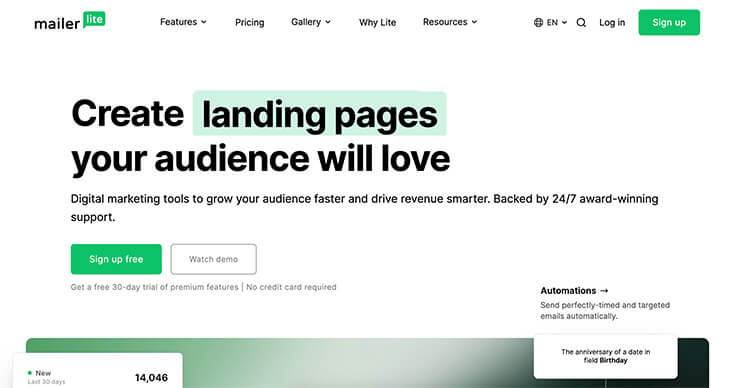
MailerLite is the Email Marketing platform I use… It’s is known for its simplicity and user-friendly interface, making it a popular choice for businesses of all sizes.
MailerLite offers robust email marketing features, including automation, landing pages, and pop-ups, without overwhelming users with complexity.
MailerLite Pricing:
MailerLite offers a free plan for up to 1,000 subscribers and 12,000 emails per month. Paid plans start at $9 per month for 1,000 subscribers, and it goes up from there, the pricing is determined by the amount of subscribers and emails you want to send so please click through to MailerLite and view the pricing page for more accurate figures.
Best For: Beginners, small businesses, and large businesses… Basically anyone looking for an intuitive and affordable email marketing solution.Personal Rating: ⭐ ⭐ ⭐ ⭐ ⭐
MailChimp
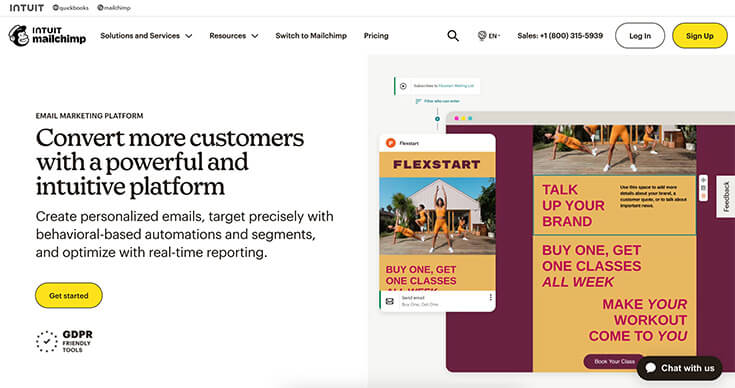
Mailchimp is one of the most well-known email marketing platforms, offering a comprehensive set of tools for businesses of all sizes. It combines email marketing with CRM, making it a powerful all-in-one marketing platform.
Mailchimp Pricing:
Mailchimp offers a free plan for up to 500 subscribers and 1000 emails per month. Paid plans start at $14.92 per month for the Essentials plan and it goes up from there, the pricing is determined by the amount of subscribers and emails you want to send so please click through to MailChimp and view the pricing page for more accurate figures.
Best For: Beginners, small businesses, and large businesses. MailChimp is a powerful industry player.Personal Rating: ⭐ ⭐ ⭐ ⭐ ⭐
Systeme.io
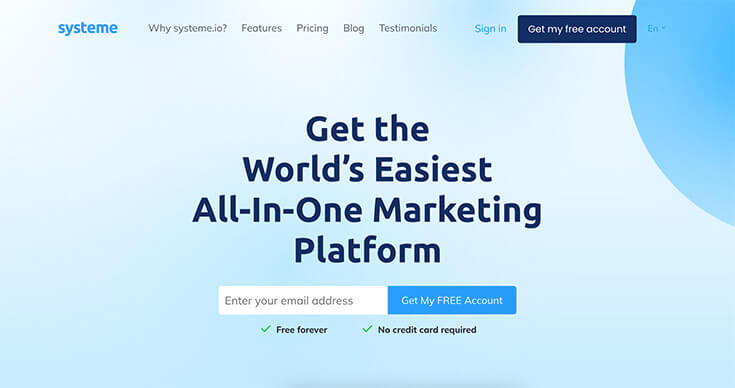
Systeme.io is a little different to the others in that it’s an all-in-one marketing platform that includes email marketing, sales funnels, membership sites, and lots more. It’s designed to be a comprehensive solution for entrepreneurs and small businesses. Definitely have a look at their features and see if they offer what you’re wanting.
Systeme.io Pricing:
Systeme.io is free up until 2000 contacts and then the paid plans start at $27 per month, and it goes up from there, the pricing is determined by the amount of subscribers and the features you want to use in Systeme.io so please click through to Systeme.io and view the pricing page for more accurate figures.
Best For: Individuals and small to medium size businesses.Personal Rating: ⭐ ⭐ ⭐ ⭐ ⭐
AWeber

AWeber is a long-standing player in the email marketing space, known for its reliable service and ease of use. It provides essential email marketing features, making it suitable for small to medium-sized businesses.
AWeber Pricing:
AWeber offers a free plan for up to 500 subscribers and 3,000 emails per month. Paid plans start at $12.50 per month for up to 500 subscribers and it goes up from there, the pricing is determined by the amount of subscribers and emails you want to send so please click through to AWeber and view the pricing page for more accurate figures.
Best For: Great for beginners, while paid plans offer scalability for growing businesses, small to medium size.Personal Rating: ⭐ ⭐ ⭐ ⭐
Constant Contact

Constant Contact is a reliable and easy-to-use email marketing platform designed for small businesses and non-profits. It offers a range of features to help users create effective email campaigns and grow their audience.
Constant Contact Pricing:
Constant Contact offers a Lite plan starting at $12 per month for up to 500 subscribers and an advanced Standard plan starting at $35 per month. The pricing increases with the number of subscribers and is determined by the amount of subscribers so please click through to Constant Contact and view the pricing page for more accurate figures.
Best For: Individuals to small businesses and larger businesses.Personal Rating: ⭐ ⭐ ⭐ ⭐ ⭐
Active Campaign
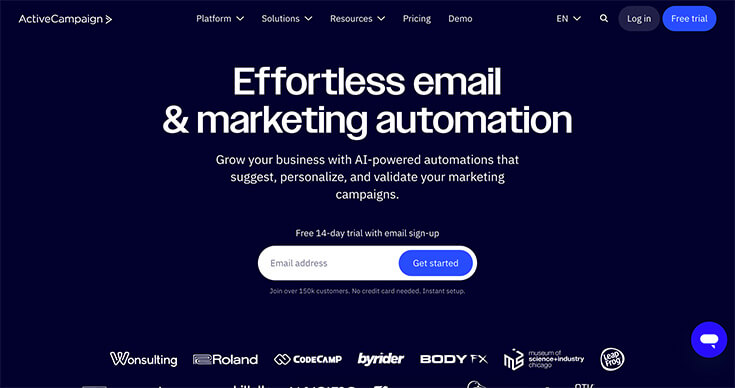
ActiveCampaign is a highly regarded platform for its advanced automation capabilities. It goes beyond email marketing, offering CRM and sales automation, making it ideal for businesses looking to streamline their marketing and sales processes.
ActiveCampaign Pricing:
ActiveCampaign’s pricing starts at $15 per month for the Starter plan, which includes 1000 subscribers and the Plus plan starts at $49 per month and adds more advanced features. Please click through to ActiveCampaign and view the pricing page for more accurate figures.
Best For: Individuals to small businesses and larger businesses.Personal Rating: ⭐ ⭐ ⭐ ⭐
Which one is best for you?
A lot of the email marketing platforms offer the same features and functionality, so my best suggestion is to see which ones best integrate with the other systems you may be using like WordPress or Calendar software platforms or any other systems you may be using to run your bbusiness.
Also, have a look at their pricing and see which one best fits your business there… After investigating a while myself, I found MailerLite worked best for me, and it got great design
Are there other Email Marketing Platforms to use?
Yes, of course!
There are probably lots out there, and while they might offer similar features and service, with my experience over the years, the names I’ve listed above are the ones that I know have been around for a long time and offer a good service and great support.
Whichever one you choose, even if it’s not in my list and you want to use them, I suggest just doing a little research before and reading reviews on their services to get an idea of what to expect when working with their platform.
Should you learn Email Marketing: My Conclusion:
I’d say Yes! To learn email marketing is a smart move in today’s digital world!
It gives you what is probably the most direct way to reach and engage your audience and build strong relationships.
If you learn email marketing and master it, you can create personalized content that connects with your subscribers, leading to better engagement and more conversions. Whether you’re a business owner, marketer, or entrepreneur, email marketing is a valuable tool that can help you achieve your goals effectively.
Sign up to my email newsletter for more 😉
Happy emailing!
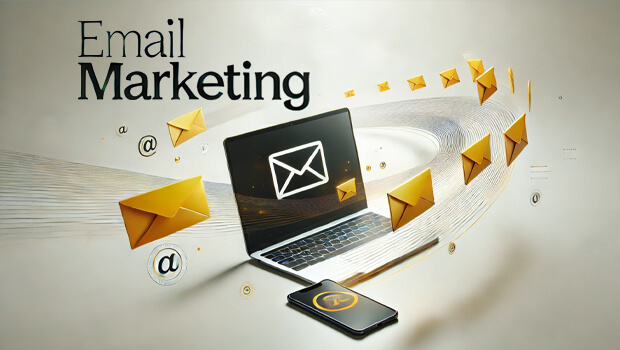

Leave a Reply